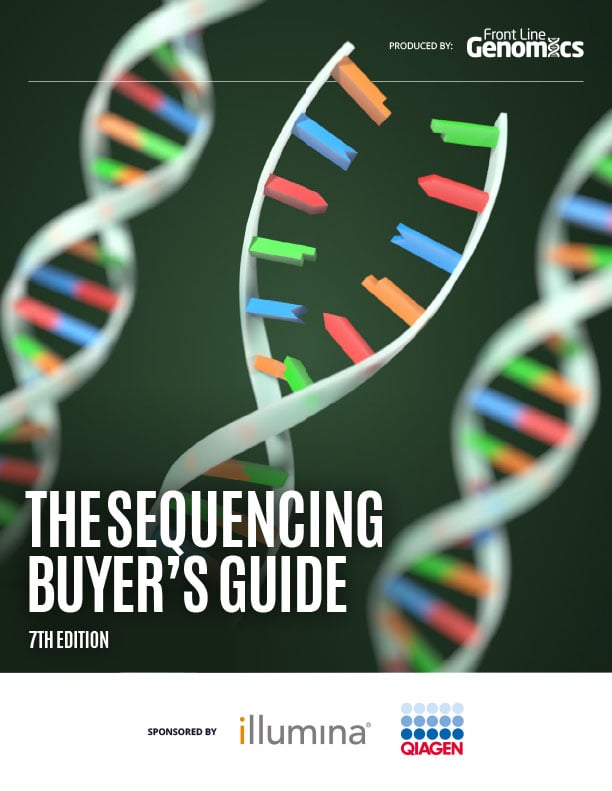
The Sequencing Buyer's Guide: 7th Edition
Next generation sequencing has become a fundamental approach in many aspects of life science research and impressive innovation continues to push the boundaries even further.
We are pleased to announce the launch of the latest edition of the Sequencing Buyer’s Guide, which explores the current sequencing landscape in detail. The start of 2025 saw an unprecedented number of groundbreaking announcements for new platforms and entirely novel methods. As such, we chose to delay the launch of this report to ensure these updates could be covered adequately, providing you with a comprehensive overview of the space.
Highlights from this buyer’s guide include:
- Interviews and panel discussions with experts across the academic, pharmaceutical and clinical sectors
- Up to date specifications of sequencing instrumentation and the reagents used to prepare samples for NGS, displayed side by side to allow comparison
- An exploration of the ethical and logistical challenges of bringing sequencing to the clinic
Hear from our Expert Contributors:
- Pankaj Agrawal, Chief of Neonatology, Holtz Children's Hospital and Jackson Health System; Chief of Neonatology and Professor of Pediatrics and Genetics, University of Miami Miller School of Medicine
- Rosie Bamford, Postdoctoral Research Fellow in the Complex Disease Epigenomics Group, University of Exeter
- Jack Bartram, Consultant Pediatric Haematologist; Haematological Genomics Clinical Lead, Great Ormond Street Hospital NHS Foundation Trust; North Thames Genomic Laboratory Hub
- Ojasvi Chaudhary, Senior Scientist, AstraZeneca
- Daniela Maria Cirillo, Group Leader, Division of Immunology, Transplantation, and Infectious Diseases, IRCCS San Raffaele Scientific Institute
- Anne Marie Comeau, Deputy Director, New England Newborn Screening Program
- Adam P. Cribbs, Associate Professor, The Botnar Institute for Musculoskeletal Sciences, University of Oxford, Josh Fienman, Senior Scientist, Genomics (Systems Immunology), Pfizer
- Josh Fienman, Senior Scientist, Genomics (Systems Immunology), Pfizer
- Bill Flynn, Associate Director, Single Cell Biology Core, The Jackson Laboratory
- Sara Goodwin, Research Assistant Professor, Cold Spring Harbor Laboratory
- Dorota Gruber, Assistant Chief, Pediatric Cardiogenomics, Northwell Health; Assistant Professor in the Departments of Pediatrics and Cardiology, Zucker School of Medicine, Hofstra/Northwell
- Gamze Gürsoy, Core Faculty Member, Herbert Irving Assistant Professor of Biomedical Informatics, Department of Biomedical Informatics, New York Genome Center
- Ingrid A. Holm, Endowed Chair in Genetics and Genomics, Boston Children's Hospital
- Miten Jain, Associate Professor, Northeastern University
- Sally James, Head of Genomics, University of York
- Niall Lennon, Senior Director Genomics Platform, Broad Institute
- Szi Kay Leung, Postdoctoral Research Fellow in the Complex Disease Epigenomics Group, University of Exeter
- Elsa Molina, Director, Single-Cell & Spatial Omics Core, Salk Institute
- Michael Peterson, Scientist I, Stowers Institute for Medical Research
- Michael Quail, Principal Scientist, DNA pipelines Research and Development Group, Wellcome Sanger Institute
- Tamara Salloum, Single-Cell Genomic Technology Specialist, Brigham and Women’s Hospital, Harvard Medical School
Contents:
Chapter 1: First Steps in Sample Preparation: Nucleic Acid Extraction
Proper sample preparation is crucial for a successful sequencing experiment. This chapter will start at the beginning of the sample preparation workflow, with nucleic acid extraction.
Chapter 2: Next Steps in Sample Preparation: Library Preparation
The next, and final, step in the sample preparation workflow for NGS is library preparation. This chapter will highlight both DNA and RNA library preparation kits for short-read and long-read systems.
Chapter 3: Meet the Short-Read Sequencers
Short-read sequencing has drastically evolved since the introduction of Sanger sequencing in 1977. This chapter overviews the current commercial selection of short read sequencing platforms. Information on Roche's new sequencing by expansion technology can be found at the end of this chapter.
Chapter 4: Introducing the Long-Read Sequencers
The development of long-read sequencing technologies has enabled researchers to explore genomes at unprecedented resolutions. In this chapter we overview the commercial long-read sequencing methods that are currently available.
Chapter 5: How to Choose Your Sequencing Technology
So, we’ve covered short-read and long-read sequencing technologies – but which technique is best for your experiment? And which specific technology should you choose? In this chapter, we outline how to choose the best sequencing technology for your experiment.
Chapter 6: Moving to Single-Cell and Spatial Multi-Omics
Sequencing has recently extended to single-cell and spatial resolutions, creating huge potential for biological discovery. On top of that, the combination of various omics as multi-omics has led to deeper biological understanding across many fields. In this chapter, we highlight key single-cell, spatial and multi-omics sequencing technologies.
Chapter 7: Opportunities in Outsourcing
Rather than investing in your own sequencing set-up, have you thought about outsourcing your experiment to an external group, department or company for them to perform? In this chapter, we highlight the options when it comes to outsourcing sequencing.
Chapter 8: Bench to Bedside: Sequencers in the Clinic
Sequencing technologies are useful for a range of applications in the clinic. However, the use of these techniques comes with challenges and ethical discussions. In this chapter we explore the challenges and ethical hurdles of the use of clinical data in genomic medicine, with newborn screening as an example.
Download Report
ABOUT US CONTACT ADVERTISE PRIVACY POLICY
Front Line Genomics Limited is registered in England and Wales. Company Number 10421716, VAT: GB 297 742 548.
Registered Office: Newfrith House, 21 Hyde Street, Winchester, SO23 7DR, United Kingdom
